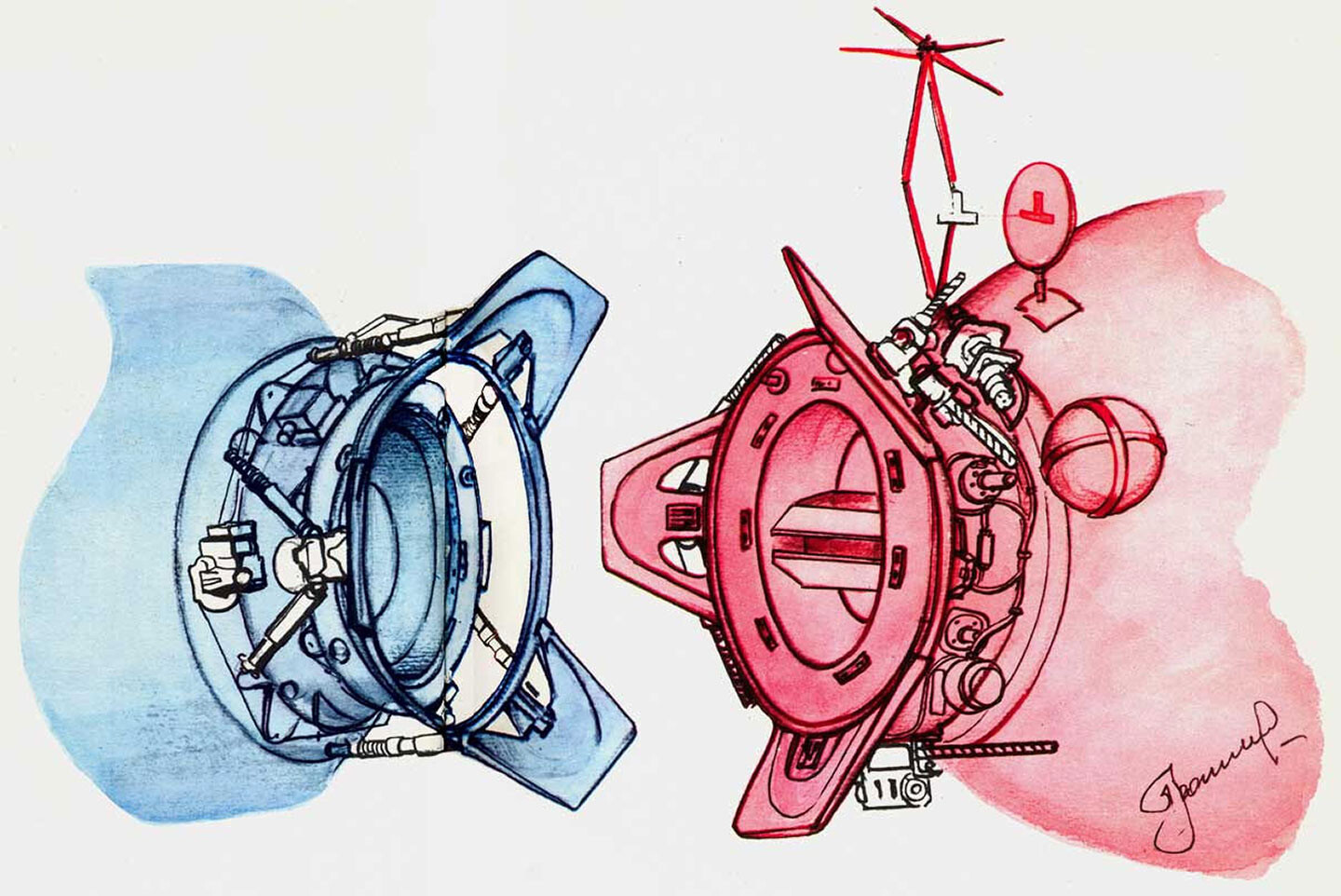On July 15, 1975, the Soviet spaceship Soyuz 19 and the American Apollo entered earth’s orbit. Two days later, on July 17, they performed the first docking together of two spaceships belonging to different countries in the history of space exploration. This event had been preceded by several agreements about joint USSR-US space exploration in the interest of the advancement of science. The first such agreement was signed in 1962, and in 1970 discussion of the jointly piloted space flight of the two ships began. The docking of the American and Soviet modules and their collaborative work in space was referred to in both countries as a “handshake in space.” It came to symbolize the dawn of the new era of international space collaboration “for the good of humanity and in the name of peace and progress.”1
The pathos of this scenario, one of the last large-scale projects that could be considered part of the modernist trajectory, compelled all those involved to carefully plan not only the technical but also the symbolic details of the operation. From today’s vantage point, the production of the semiotic system of the Soyuz-Apollo project appears so well-implemented as to be unsurpassed. Elements of this semiotic system have locked into their grooves so well that the symbolism continues to work, long after the actual spaceships parted ways on July 19, 1975. The persistence of the symbolism enables us to take a closer look at the manifold patterns concealed behind the seemingly polished surface of a scientific project. Today, this expensive international experiment, meant to herald humanity’s technological triumph, could be understood as one of the most spectacular occult actions of contemporary civilization.
Tragedy is reborn when science becomes painfully aware of its limitations, wrote Nietzsche. We will attempt to listen to the tragic chorus of the Soyuz-Apollo project. Perhaps following these voices will allow us to slightly shift the orbits on which the two ships circled forty years ago, and to send their movements along a trajectory that was not officially mapped by ground control in 1975. To do this, I would like to first step into a lab filled with the acrid smoke of material experiments in the period before the modern era and its scientific methods, studying texts written by people for whom the modern world order—the same world order that began to painfully convulse in the twentieth century—had not yet solidified.
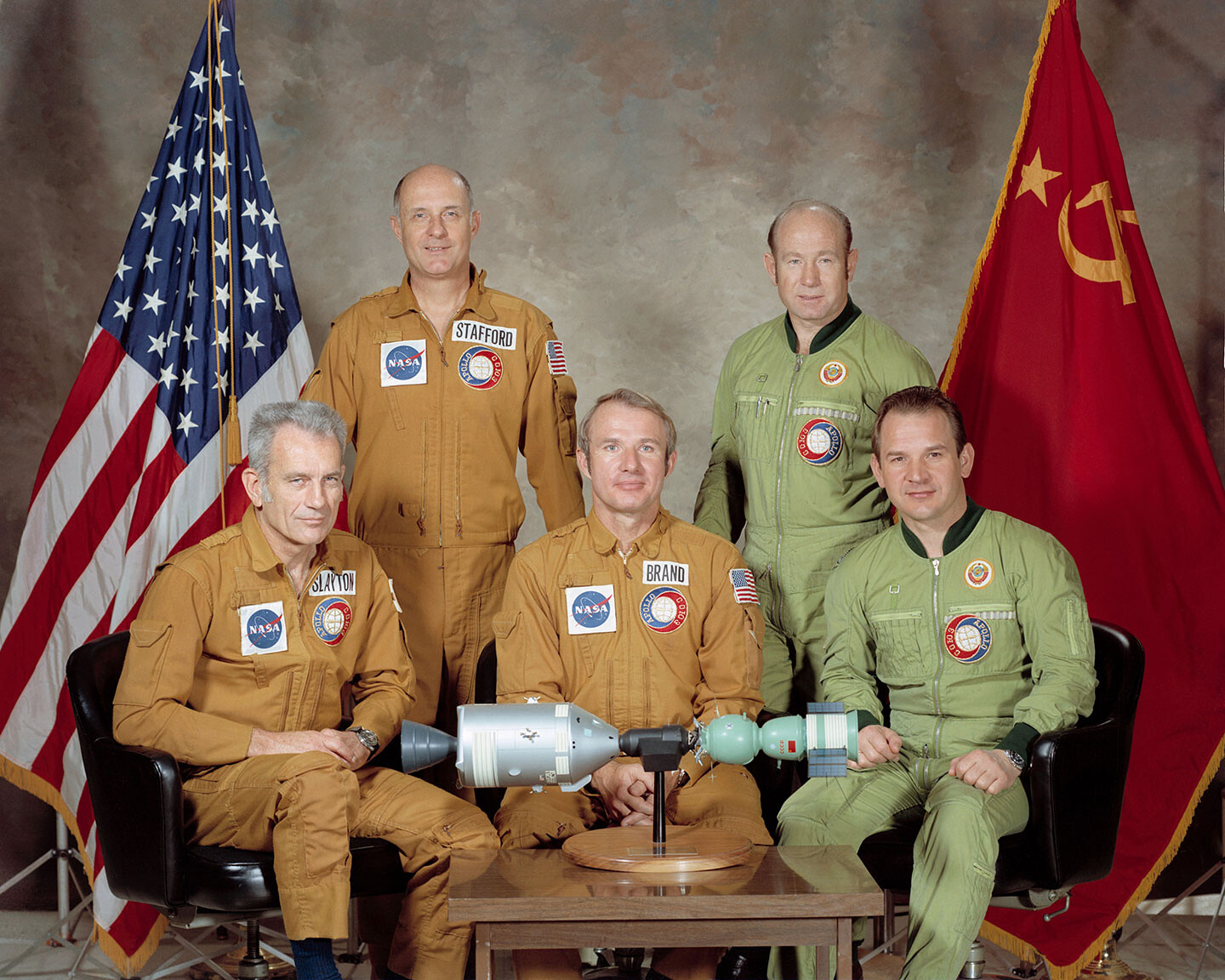

The Sovient Soyuz and the American Apollo teams. From left to right: Donald Slayton, Thomas Stafford, Vance Brand (Apollo), Aleksey Leonov, Valeriy Kubasov (Soyuz), 1975.
Cosmic Androgyne
The core symbolic and scientific meaning of the Soyuz-Apollo project lay in the successful docking of the two ships out in earth’s orbit. Two modules with very different technical characteristics were supposed to become one: to sync up their movements and the operations of their technological guts. Until then, all apparatuses used for space dockings required a system with an active shaft that had to enter into the opening of its passive counterpart (or, as engineers call it in their professional argot, a “mother-father” system). For the obvious reason that neither country could be represented in a passive role, this system was unacceptable for the encounter of American and Soviet modules. In the 1960s, the Soviet academic Sergey Korolev had already formulated the technical task for future generation of spaceship designers, urging them to “create docking apparatuses which would be the same on both ships and provide astronauts with a communicating passageway tunnel.”2 It was this exact construction that was realized for the first time in the Soyuz-Apollo project. It was called an Androgynous Peripheral Attach System—APAS for short.
Such attach systems, installed on both ships, were completely identical and each could simultaneously perform passive and active functions. Grabbing mechanisms were placed along the round circumference of the apparatus on each ship. A tunnel formed after the docking was to provide a passageway for the astronauts. It was in this tunnel that Soviet and American astronauts were supposed to have their first handshake in space. Essentially, APAS was the protagonist of the entire enterprise (its acronym only differed by a letter from the acronym for the whole experiment: the Apollo-Soyuz Test Project, ASTP). It made the docking of the two ships symbolically neutral and allowed the handshake to happen. Symbolically as well as practically, this androgyne occupied a central place in the joint space apparatus, firmly holding its two parts together and permitting the new hybrid spaceship to function.
The androgyne figure is one of the key concepts in ancient esoteric teachings as well as in mystical branches of early and medieval Christianity.3 The alchemical tradition, which flourished in Christian Europe in the eighth to seventeenth centuries, derived its ideas about androgynes from Greek mythology and Gnostic texts.4 In alchemy, the androgyne is a result of a so-called alchemical marriage—a mixing of sulfur and mercury, the two principal alchemical elements, purified in a special way. Their combination, made in correct proportion, was believed to produce the philosopher’s stone, which could, among other things, change metal into gold. Mercury signified a feminine element, while sulfur was masculine.5 In general, one of the foundational principles of alchemical experiments was the presence of both genders, of two complimentary elements capable of entering into contact with each other. The sacred number two is foundational for alchemical processes. Within the alchemical system, everything is paired: earth and sky, sulfur and mercury, east and west, the moon and the sun, the Christian tradition and paganism, the clear recipe and the esoteric messages. The union of irreconcilable elements, the merging of opposites, not only gives birth to the sought-after philosopher’s stone, but also helps achieve universal wisdom and eternal intellectual enlightenment. In this regard, a space experiment “for the good of humanity” is not all that different from the alchemical pursuit, whose ultimate aim was for the alchemist-demiurge to achieve power over the mystery of the universe.
Alchemists shared the ancient Persian belief that a wise magician able to penetrate this mystery may be born only out of an unnatural, incestuous union. The Soviet engineers’ description of the union of the two space modules—the unnatural union of two antagonistic countries—resembles a mating ritual: “During the approach, a passive ship does not remain entirely passive. Its radio station provides the active ship with all the necessary information. It automatically locates its partner and, in the process of approach, rotates its docking port towards the docking port of its partner.”6 After two rotations around the earth side by side, the machines were to connect their docking systems, forming one white body glowing against the background of black open space.7
“Earth and Sky were married. A child shall be born to them. For whiteness is a sign of the sacred union of the stable and the evanescent, of the male and female.” In this way Antoine-Joseph Pernety, a seventeenth-century French alchemist, describes a successful union of alchemical elements in his System of Physics According to Hermetic Philosophy and Theory and Practice of the Magisterium.8 A properly performed wedding ceremony opens the road to other transformations: a child-APAS, a keeper of the mystery of the sacred union, proudly lifts its male-female face and points the way toward further alchemical recipes.


Illustration by Alexey Leonov (1975)
Sick Gold
The handshake successfully took place. After docking and shaking hands, the two Soviet cosmonauts (Aleksey Leonov and Valeriy Kubasov) and three American astronauts (Thomas Stafford, Donald Slayton, and Vance Brand) had planned to conduct a series of complex experiments while in orbit. However, first, a dinner was to take place. The menu consisted of borscht, entrecôte, juice, and black bread. Leonov, the good-natured captain of the Soyuz, decided to play a prank on his American colleagues; he attached Soviet vodka labels to the tubes of borscht and insisted that the American astronauts drink with their Soviet colleagues. Stafford and Slayton (Brand stayed on Apollo) were very confused and resisted for a while. But once they finally conceded, they were surprised to discover that instead of alcohol, their tubes contained innocuous soup.9
Every successful alchemist had to have a creative and playful approach. Alchemical recipes often took the form of riddles and always left room for improvisation. The practitioner was advised to approximate this or that ingredient, and the ingredients themselves were often described in a coded or poetic manner (heat up the green lion and evaporate the red dragon, so that the snake will eat its tail and the black crow will cast a shadow on the glass retort, etc.). According to V. L. Rabinovich, who published the first study of alchemy in the Soviet Union in 1975, this kind of codification served to protect recipes from the uninitiated. Moreover, the success of the experiment depended on how experienced a given alchemist was in “eyeballing” his ingredients.10 Therefore, despite referring to an authoritative recipe, in order to actually obtain the philosopher’s stone and the golden essence an alchemist had to act as an artist, introducing an element of play into the technical process. Similarly, during the space flight, when each minute was strictly accounted for, the astronauts still managed to leave space for creative disorder and play.11
Hardly anything in alchemical texts should be taken literally. Behind each word is a hidden symbolic meaning, and its possible interpretations are almost always contradictory. If we consider the dinner in space as another alchemical recipe, it too would point to something beyond itself. Vodka, which made its surprising appearance on the docked ship, even if only represented by stickers attached to the food tubes, takes its place among the ingredients of this cosmic alchemical experiment. In alchemy the concept of strong vodka might correspond to nitric acid—the derivation of the latter was one of the earliest alchemical experimental traditions, sanctified by the highest alchemical authorities.12 Nitric acid was used to dissolve mercury and sulfur to purify them before any further attempts at synthesizing the philosopher’s stone could be made.The entrecôte consumed during dinner was a cut of beef from the rib area (in French, entre-côte means literally “between the ribs”). Here we are dealing not with the alchemical, but with the Biblical tradition, namely with the story of doubting Thomas, who poked the wound between Christ’s ribs after his resurrection. With this gesture, Thomas ascertained that Christ’s spirit had not been resurrected alone; to the surprise of all the apostles, Christ’s flesh in all its materiality had been restored to life as well. The theological question of whether or not Christ had been resurrected in the flesh was very actively debated in the early days of Christianity. While the Church would eventually officially insist on complete physical resurrection, Gnostic Christians had their doubts. In the Gnostic Gospel of Thomas, Christ addresses his disciple with the following words: “If the flesh came into being because of spirit, it is a wonder. But if spirit came into being because of the body, it is a wonder of wonders. Indeed, I am amazed at how this great wealth has made its home in this poverty.”13 According to the Gnostics, Thomas was not all that interested in pushing his fingers into Christ’s wound, since the material aspects no longer played an important role for the spirit once the spirit had uncovered cosmic infinity.
Alchemy combined Gnostic and more orthodox Christian elements and developed its own understanding of materiality. On the one hand, unlike the Gnostics, with their disdain for the physical world, alchemists strove to master materiality through experiments and learn how to directly influence material properties. In their writings they described, with considerable attention and imagination, colors and textures obtained as a result of exceedingly laborious experiments. On the other hand, unlike medieval Christians, alchemists held that, just like God, they too could completely transform the external appearance as well as inner constitution of substances and morph one body into another so completely that the old one would disappear without a trace. “Even God … in the end may be equated with gold—as well as with any other substance. This has to do with the principal indeterminacy of matter. Such fundamental lack of organization and structure of the physical world can easily give one vertigo.”14 Gold, at the apex of the alchemical hierarchy of material substances, was the only truly pure element and could penetrate all. All materials that were not gold were simply its sick iterations in need of treatment. If a cure were administered correctly, the metal would be freed from corruption, would regain its lost state of purity, and would once again become gold.15 The entrecôte eaten at the astronauts’ dinner reveals a connection between these three traditions and introduces into the alchemical recipe of the mission yet another alchemical element: the knowledge of the complete mutability of material bodies.
The air that the Soyuz crew breathed was an oxygen-nitrogen mixture, while the astronauts on Apollo were inhaling pure, unmixed oxygen. After the docking and opening of the hatches, the two air compounds blended, a sort of alchemical merger of the different internal environments. After their ships were joined, the crews of Apollo and Soyuz began conducting joint experiments as part of the intiative EPAS (Experimental Project Apollo-Soyuz, an acronym again only one letter away from APAS, the name of the docking system).16 One of them, bearing the rather alchemical name of “the universal stove,” was meant to ascertain whether it was possible to achieve a uniform character of metallic alloys and the ideal lattice structure of metals in zero-gravity conditions. The purpose of another experiment, titled “microbial exchange,” was to study the composition of microorganisms living on the skin and mucous membranes of the astronauts as well as the microflora of the two ships. As with the blending of the atmospheres of the two ships after the opening of the hatches, their microbial environments ended up forming a composite.17
The quality and extent to which composite parts blend to form a homogeneous and radically new product is the mark of success for an alchemical experiment. “Just as in the result of the blending of two molecules a new element gets synthesized that has qualities not found in either of the original elements, so did the docking of Soyuz and Apollo, the two spaceships of very different ‘characters,’ form a new dynamic system that possessed properties absent in either of its composite parts”—according to one of the engineers from the EPAS working group.18 In this sense, the new system was formed thanks to complete molecular mixing. Although alchemists denied the atomic structure of metals and insisted that new elements could be born through blending, in the scientific and technical history of twentieth-century space exploration, a birth could be achieved only by passing through articulate stages of microbial and molecular exchange.
Perhaps the most curious experiment took place during the first of the two (two again!) undockings of Soyuz and Apollo. In order to conduct the “artificial solar eclipse” experiment, Apollo was to position itself with regard to Soyuz in such a way as to completely block the sun from the Soviet ship. Then the Soyuz crew could clearly view the so-called solar crown—the upper rarefied atmospheric layers consisting of ionizied hydrogenic plasma—and take a series of photographs to be further studied by scientists back on earth. Sun and moon, those alchemical parents, gold and silver, sulfur and mercury, were called to form an alloy—an androgynous child. However, as we have seen, the androgyne had already been born during the successful docking of the two spaceships, taking its symbolical place between the two gigantic cosmic retorts of Soyuz and Apollo. Therefore, the processes initiated by such a birth had already begun. These were the processes of comprehensive/universal blending, of symbolical metamorphoses, of material production, and of cosmic intellectual renewal. Within such a logic, Apollo, the alchemical embodiment of both gold and the sun, was made to occupy the place of the moon, and therefore, by default, the moon became the sun. This is exactly what happened during the space experiment: out of their hatches, Soyuz’s crew could simultaneously observe two suns and two moons, since both the Apollo-moon and the star-sun simultaneously became each other’s opposites.19 The passengers on Soyuz (which means “union” in Russian) witnessed and photographed this transmutation, once again emphasizing the close bonds of the lovers’ union between moon and sun, sky and earth.
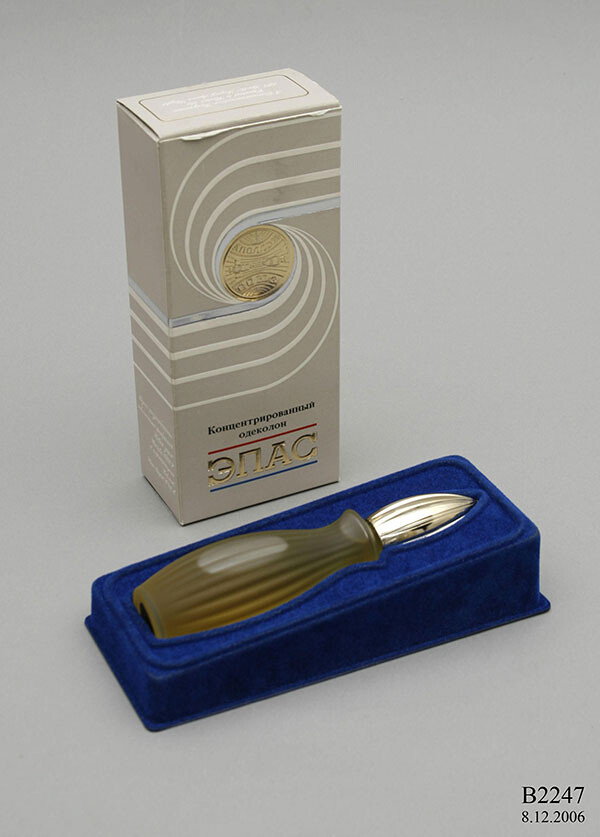

Original package and bottle of EPAS perfume, 1975.
The Stench of Putrefaction and the Aroma of Success
And what was happening back on earth during this cosmic experiment? The day of the docking saw the release of EPAS, a perfume manufactured through joint Soviet-American efforts; the perfume bottle was American, while its contents were a French-Soviet production. Another commemorative product was the Soyuz-Apollo brand of cigarettes, designed by Philip Morris and produced at the Moscow “Java” factory. It is not exactly clear why, out of the entire range of possible souvenir goods, perfume and cigarettes were manufactured. The simplest explanation is that the manufacturers wished to reach male and female demographics with the two broadest possible strokes. However, viewed through our “alchemical” prism, this decision too does not appear accidental.
The Soyuz-Apollo cigarette pack featured an image of a black circle, which could clearly refer to that solar eclipse. The contents of the pack also possess dual properties. First of all, smoking inevitably creates acrid-smelling smoke. Secondly, no matter how much the proponents of smoking would like to deny this, all cigarettes bear a strong visual association with smoker’s rotting lungs that begin to darken and decay while the smoker is still alive. Darkening, decay, and decomposition of material is the first of many stages of alchemical transformation, during which original substances are destroyed to give way to further mutations. Alchemists believed that at this stage, a practitioner killed a substance and then manipulated the dead material, which was no longer resistant. In the end, after passing through all the stages of transformation, it was hoped that the material would become alive again, this time in the form of gold. The demiurge alchemist, ruling over life and death, would produce an alchemical miracle and renewed light would shine through the decomposed matter.20 The black rot of decay is just a starting point for the ambitious and creative alchemical enterprise of transforming the world.
For its part, the EPAS perfume is easily recognizable as the golden essence. Its golden lid and the golden (not black, as on the cigarette pack) circle on its label signified the shining success of the experiment that was being conducted in space. The philosopher’s stone, the alchemical ur-matter, has been found at last. The name of the perfume—the abbreviated name of the entire project—is a homonym of the English “e-pass” and the French “e-passe.” The essence contained in this bottle signifies a passage—but a passage to where? Into what dimension is this space experiment directed? What door is supposed to open as a result of the triggered alchemical transformations?
The Soyuz-Apollo cigarettes and the EPAS perfume framed the initial and the end stages of an experiment that had been taking place in the sky. Soyuz and Apollo had been sent out into dark, empty space to couple. But why did the experiment have to take place in space in the first place? Why did both nations have to conduct the entire series of necessary transmutations off the planet? Let’s try to understand why it was necessary to produce a celestial and not a terrestrial androgyne. On the one hand, the hermetically sealed spaceship forced its crew to strictly abide by the prescribed plan. This made it easier to ensure that all stages of the alchemical recipe were followed through in their proper order: dozens ground-control operators closely watched over the proceedings on the ship. But as we’ve already seen, even despite such a high level of control, the astronaut-alchemists managed to pull off one or two creative tricks.
More to the point, in space, no accident or foreign chemical admixture could interfere with the purity of the experiments conducted there. Any mistake would have proven fatal. Out in space everything runs according to the “all or nothing” principle. For this reason, Peter Sloterdijk compares spaceships to islands and considers them as miniature models of the world. “If islands are the models of the world,” writes Sloterdijk, “that is because they are sufficiently removed from the context of the world for an experiment of restoring totality in a limited form to take place.”21 Following Sloterdijk’s thought, this project, conducted by only two of earth’s countries, becomes an expressive symbol of a global pursuit.
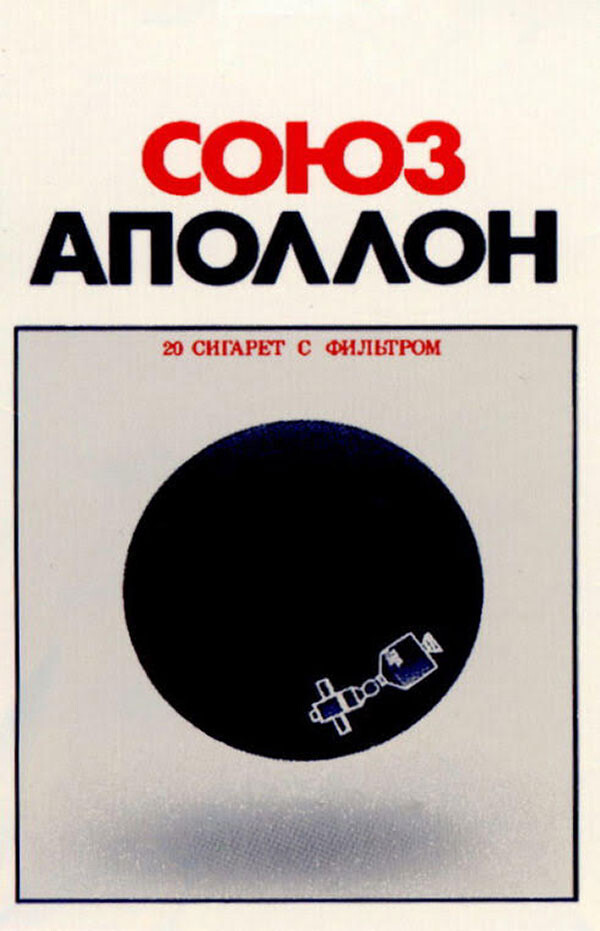

Package of “Soyuz-Apollon” cigarettes, 1975.
Finally, it is the very immensity of the distance between the top (the Soyuz and Apollo ships, floating in their celestial union in earth’s orbit) and the bottom (of the cigarettes and perfume used on earth and framing the entire experiment) that runites them. For an alchemist, the top and the bottom are not opposites; the alchemist’s world is simultaneously manifold and horizontal, and the top and the bottom are constantly switching places. What is sacred and divine is profaned until it dissolves in a glass retort, while the metals extracted from the bowels of the earth gain divine properties. The legendary Hermes Trismegistus, the first alchemist and a great sage, provided the foundations of this worldview. In his Emerald Tablet he writes: “What is above is like what is below, and what is below is like that which is above. To make the miracle of the one thing.”22 Cosmic skies descend upon earth, while the weight of the earth moves upward. An androgynous ship, two mutating deities, rotting metals, a black sun, aromatic cigarette smoke, and golden essences all dance around in orbit. Eventually, under their own weight, they begin to deviate from the orbit and start moving in a new direction, the passage into which has just been opened.
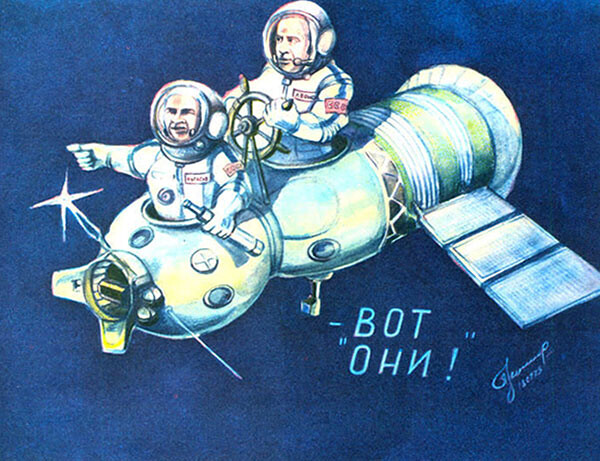

Illustration by Alexey Leonov (1975)
Shifted Orbits
Where does the new passageway opened as a result of the successful Apollo-Soyuz flight really lead? The Gnostic Gospels, which inspired alchemists over many centuries, provide a clue. For the longest time, Christianity has denounced these texts as heretical because their authors and followers refused to comply with the Church orthodoxy. If one were to describe the Gnostic doctrine in the most concise form, one would call it a system with a radically open architecture. The process of acquiring knowledge, for Gnostics, was always more important than any ossified canon. How can one penetrate a divine mystery if one cannot approach existing texts as an artist, adding something new to them with each encounter? Any person can solve cosmic riddles, provided they approach them creatively enough. That’s why Gnosticism has always been an elite, esoteric teaching that nevertheless holds a door open for newcomers.23
Gnosticism insists on complete equality between men and women. In the Gnostic Gospel of Philip, we read that Jesus loved and was closer to Mary Magdalene than to any of his male disciples. And the Gospel of Mary Magdalene says that it was she who inspired the otherwise despondent followers of Christ to go and spread his teachings after his execution.24 Female Gnostics in the first centuries of Christianity were so emancipated that their conduct earned a harsh rebuke from the early Christian writer Tertullian: “These heretical women—how impudent they are! They are immodest, they are daring enough to argue, to teach, to cast spells, to heal, and maybe even to baptize.”25 Moreover, the Gnostic God describes itself in the following way: “For I am the first and the last. / I am the honored one and the scorned one. / I am the whore and the holy one. / I am the wife and the virgin. / I am <the mother> and the daughter. / I am the members of my mother. / I am the barren one and many are her sons.”26 As you can see from this passage, Gnostic teaching shares with alchemy the principle of the unity of opposites.


Obama cries after the Sandy Hook massacre, 2012.

An anti-suffrage poster, date unknown.

Johnny Depp’s notorious tear in Crybaby (1990).

The teardrop face tattoo on former prisoner Jeremy Meeks. The tattoo used to be a gang sign and signifies the tears prisoners cannot cry while being inside.

John Boehner is known for often crying in public. There is even a Politico article about this.
Such is alchemy’s attitude toward its own symbolic system. The alchemical sign is always polysemantic. The meanings that it contains are frequently contradictory. It is always open to new interpretations. In a way, it requires them. At the same time, alchemy’s faithfulness to its symbolic system was one of the reasons why alchemists risked being burned alive by the Christian Church. A symbol is always prepared to point in the direction of a truth that is temporarily captured in it. This is why symbolic thinking is always iconoclastic.27 It rejects the transcendental inaccessibility and solidity of divine truths, because a symbol is always ready to reveal those truths before our eyes. The alchemist is always an iconoclast, a medieval Christian terrorist, trying to implode from inside the rigid logic of religious dogma.
The Soyuz-Apollo project was the culmination of the symbolical game of late modernism. The reason its symbols were presented in such a crude and direct manner is that it was already too late for any transcendental truths. Having demolished medieval metaphysics, modern humanity had entered an airless space, within which medieval symbols began to form a new and thoroughly secular system. This system was no longer built around a single god—he had been replaced by a multiplicity of dark, smoke-filled laboratories where transformations for a new alchemical recipe were and still are taking place today.
The force of pathos behind the Apollo and Soyuz flight was apparently strong enough to overwhelm the strictly scientific and rational premises of this project. It is as if the project prophesized today’s chaotic commingling of ingredients outside of any plan or recipe, a time that hadn’t yet arrived in 1975. We, as people who live in this new time, can observe all around us the unfolding of open structures worldwide. The internet and networked technologies make room for brand-new communication, social connection, and eventually ontological shift. Within a network, one can simultaneously encounter strict mathematical calculation and the abstraction of a mystical tractatus, iconoclastic pathos and jokes about the emergence of a new religion that lays its claims with the seriousness of revelation. Everything can transform into everything else; unequal can become equal. Yet the logic of these new compounds remains concealed from us by the smoke of an alchemical experiment. Circumferences that conjoin opposite poles have been drawn apart, yet the many-faced space androgyne continues its flight. It carries within itself all combinations—combinations that can only be imagined. The flight of imagination happens at just such moments in history, when the simplest-seeming logic becomes clouded with the smoke of lit cigarettes.
“Soyuz” i “Apollon”: Rasskazyvaiut sovetskie uchenye, inzhenery i kosmonavty—uchastniki sovmestnyh rabot s amerikanskimi spetsialistami, ed. K. D. Bushuev (Izdatel’stvo politicheskoi literatury, 1976), 8.
“Soyuz” i “Apollon,” 123.
Soviet engineers made several curious remarks on the subject. “By the way, we’ve borrowed the term ‘androgynous’ from mythology: androgynes were hermaphroditic creatures,” confessed V. S. Syromiatnikov, the leader of the third ASTP work group. “Soyuz” i “Apollon,” 121.
The following passage is from the Gnostic Trimorphic Protennoia: “I am androgynous. I am Mother (and) I am Father, since I copulate with myself. I copulated with myself and with those who love me, and it is through me alone that the All stands firm. I am the Womb that gives shape to the All by giving birth to the Light that shines in splendor. I am the Aeon to come. I am the fulfillment of the All, that is, Meirothea, the glory of the Mother. I cast voiced Speech into the ears of those who know me.” See →.
See the first study of alchemy published in the Soviet Union: V. L. Rabinovich, Alhimiia kak fenomen srednevekovoi kul’tury (Nauka, 1979).
“Soyuz” i “Apollon,” 102.
One of the most difficult issues that American and Soviet engineers had to face was coordinating flight trajectories of the two ships to ensure their successful docking. Since space exploration programs in the Soviet Union and the US had been developing independently of each other, each country had a different model for calculating ballistics. The task of reconciling these models was extremely difficult. Later, engineer O. G. Sytin would write: “We managed to achieve practical compatibility of our ballistic calculations for a real flight. When everything was over, we would joke and say that we made everything possible and even made use of the ‘k-ballistics.’” “Soyuz” i “Apollon,” 96. It is hard to imagine anything more different than precise twentieth-century cosmic science and esoteric teachings. At the same time, these systems are polar opposites to such an extent that at some points they begin to collapse into each other.
Quoted in Rabinovich, Alhimiia, 98.
“I brought several vodka labels from earth—Stolichnaya and Osobaya—and attached them to the food tubes. Once we were all seated around the table I handed everyone their tube. ‘Come on, guys,’ I said. ’We can’t.’ ’It’s a Russian tradition. Before we eat, we must drink Russian vodka. It’s very good for your stomach.’ They stopped protesting. We opened the tubes and cheered. We have photos of Deke Slayton looking bewildered, having just discovered that it was borscht and not vodka after all. That was a simple human joke.” See →.
Rabinovich, Alhimiia, especially the chapter “Alhimicheskii retsept: deistvie i sviashennodeistvie.”
In another interview, Leonov spoke of an instance of improvisation during the flight: “During one of the discussions of the Apollo-Soyuz flight, there was an argument about what minimal distance should be maintained between the two ships, before the mutual maneuvers could begin. Until the very last moment, NASA bureaucrats kept on insisting that the distance between our ships could not be less than 150 meters. However, Tom Stafford, Apollo’s captain, disagreed and insisted that forty-five meters would suffice. At that moment, I pulled Stafford out of the room and told him: ‘They won’t be there to control us once we are out in space. Let’s just act as we see fit and not tell them about it.’” See →.
Rabinovich, Alhimiia, 59.
See →.
Rabinovich, Alhimiia, 79.
Rabinovich, Alhimiia, 79.
For more on the experiments conducted during the Soyuz-Apollo flight, see NASA’s Apollo-Soyuz Mission documentary film (1975) →.
Engineeer V. A. Ol’shevskii noted that “most of the microbes (they) found were on the surface of the docking tunnel and in the parts of the ship closest to the docking apparatus.” “Soyuz” i “Apollon,” 191.
“Soyuz” i “Apollon,” 112.
Besides, “alchemical gold and silver form a pair, yet they are hardly opposites. They represent the gradations of perfection.” Rabinovich, Alhimiia, 108. Gold and silver, sun and moon can trade places as easily as any of the components of the alchemical pairs.
“Matter, once it is animated by fire, begins to darken. Black contains white, yellow, and red colors. White for alchemists did not signify higher purity—it was simply one color among many. Black, on the other hand, was believed to be as a source of all other colors.” Rabinovich, Alhimiia, 93.
Peter Sloterdijk. Foams: Spheres, Volume III (Nauka, 2010), 313.
See →.
Elaine Pagels writes: “Valentinus and his followers … argued that only one’s own experience offers the ultimate criterion of truth, taking precedence over all secondhand testimony and all tradition—even gnostic tradition! They celebrated every form of creative invention as evidence that a person has become spiritually alive. On this theory, the structure of authority can never be fixed into an institutional framework: it must remain spontaneous, charismatic, and open.” Pagels, The Gnostic Gospels (Vintage Books, 1989), 25.
For instance, consider the following lines from the Gnostic Gospel of Philip: “And the companion of … Mary Magdalene … loved her more than all the disciples, and used to kiss her often on her mouth. The rest of the disciples … said to him, ‘Why do you love her more than all of us?’ The Savior answered and said to them, ‘Why do I not love you like her? When a blind man and one who sees are both together in darkness, they are no different from one another. When the light comes, then he who sees will see the light, and he who is blind will remain in darkness.’” See →.
Tertullian, De cultu feminarum, ca. 190–220AD.
See →.
Rabinovich, Alhimiia, 85.
Subject
Translated from the Russian by Anastasiya Ospiova.
